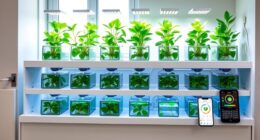Imagine a future where your waste doesn’t just end up in landfills but becomes a source of clean, renewable energy. Green Tech Guru is making this a reality by turning discarded materials into power through innovative technologies. As these solutions grow more advanced and widespread, they could transform how we manage waste and fight pollution. Curious about how this shift might reshape our environment and economy? The possibilities are more promising than you might think.
The Inspiration Behind Turning Trash Into Treasure
Many green innovators are driven by the desire to reduce waste and protect the environment. You might feel frustrated seeing mountains of trash piling up, knowing that much of it could be repurposed or recycled. This motivation fuels your passion to find smarter ways to handle waste, transforming what seems useless into something valuable. Incorporating mindful decluttering strategies can help streamline efforts and maximize sustainable impact. You see potential in discarded materials—turning landfill-bound trash into a source of clean energy. Your inspiration comes from understanding the dire need for sustainable solutions and recognizing the immense impact waste-to-energy projects can have.
Every piece of waste you convert into power is a step toward a healthier planet. This drive pushes you to innovate, challenge traditional methods, and turn environmental problems into opportunities for positive change.
Innovative Technologies Making Waste Power Possible
Advancements in technology are transforming how we convert waste into usable energy. You now have access to innovative methods like pyrolysis, which heats waste in the absence of oxygen to produce oil, gas, and char. renewable energy innovations Gasification is another breakthrough, where waste is heated at high temperatures with limited oxygen, creating syngas that can generate electricity or fuels. Anaerobic digestion uses microbes to break down organic waste, producing biogas for power and heat. These technologies improve efficiency, reduce emissions, and make waste-to-energy projects more viable. You can harness these advancements to turn trash into clean power, helping communities reduce landfill reliance and cut greenhouse gases. With ongoing innovation, waste conversion becomes more sustainable and accessible, shaping a greener future.
Real-World Applications and Success Stories
Across the globe, innovative waste-to-energy projects are demonstrating how cutting-edge technologies translate into tangible benefits. In cities like Stockholm, waste is converted into electricity that powers thousands of homes, drastically reducing landfill use and emissions.
In India, small-scale waste-to-energy plants help rural communities generate power from local waste, improving living conditions. The United States has seen success with biogas facilities turning agricultural waste into clean fuel, supporting local industries.
These projects not only produce renewable energy but also create jobs and improve waste management. You can see how these real-world applications make a difference, turning discarded materials into valuable resources. Additionally, advances in AI-driven optimization are enhancing the efficiency and scalability of waste-to-energy systems, paving the way for broader adoption.
As more communities adopt these solutions, they showcase the potential for waste-to-energy technology to transform the way we power our world.
Challenges and Opportunities in Waste-to-Energy Solutions
While waste-to-energy technologies offer promising solutions, they also face significant challenges that could hinder their widespread adoption. You might encounter high upfront costs for plant construction and technology upgrades, making investors hesitant.
Regulatory hurdles and environmental concerns, like emissions and ash disposal, can slow progress. Public perception often questions safety and sustainability, creating community resistance.
However, these challenges also present opportunities. Advances in cleaner technologies reduce emissions, and policy incentives can lower financial barriers. Creative practice can foster innovative approaches to overcoming these obstacles, encouraging new solutions and strategies.
Improving waste sorting and processing can increase efficiency, making projects more viable. By addressing regulatory and environmental concerns proactively, you open doors to more sustainable energy solutions.
Embracing innovation and collaboration helps turn these challenges into opportunities, advancing waste-to-energy as a key part of the clean energy landscape.
The Future of Sustainable Energy and Global Impact
The progress in waste-to-energy solutions highlights the broader shift toward sustainable energy sources that can significantly reduce our reliance on fossil fuels. As technology advances, you’ll see more efficient methods for converting waste into clean power, helping lower greenhouse gas emissions. Incorporating advanced projector technology can further enhance educational and training programs related to renewable energy initiatives. This shift isn’t just about cleaner energy; it’s about creating a resilient and diversified energy landscape. You play a role in supporting policies and innovations that prioritize renewable sources like waste-to-energy, solar, and wind. The global impact of these efforts can lead to reduced pollution, improved public health, and economic growth through green job creation. The future holds the promise of a more sustainable world where waste becomes a valuable resource, powering communities without harming the planet.
Conclusion
By embracing waste-to-energy technologies, you’re helping turn trash into a powerful resource that fuels a cleaner, greener future. Your innovations not only reduce pollution but also create green jobs and inspire global change. Keep pushing forward, because every step you take brings us closer to a sustainable world where waste becomes a valuable asset. Together, you’re shaping a future where energy is clean, renewable, and better for everyone.



